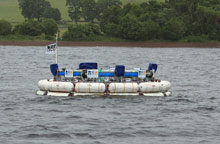By Phil McKenna
An unusual sea creature is emerging from Loch Ness in Scotland: a monster-sized floating doughnut. Wave energy startup AWS Ocean Energy recently tested this novel wave power device on the surface of the famous lake. Now, thanks to a recent investment from Alstom, a large French power equipment manufacturer, a 60-meter-diameter version could soon produce megawatts of power as it bobs in the open ocean.
The device is divided into cells, each consisting of inflatable rubber diaphragm and a bidirectional air turbine. Each cell faces toward oncoming waves. The diaphragm of each cell contracts under pressure from passing waves, forcing air through the turbines to generate electricity. The air is then fed either into a central collection chamber, or into the diaphragm of another cell elsewhere on the ring. Each time air passes through a turbine, whether exiting or entering a cell, electricity is generated.

“There is an exchange of air between cells which are out-of-phase,” says AWS chief executive Simon Grey. “This exchange is taking place via at least two turbines, exiting from one cell and entering another, and the ring main, at any given time.”
Richard Boud, an associate director at AMEC, a global engineering company based in London, says the backing of a large equipment manufacturer like Alstom is a significant step. “Alstom has a supply chain, they have a manufacturing base, they have the ability to scale up the product once they develop it,” he says.
However, the initial investment from Alstom may not lead to commercial development, Boud says. “They have marked their dance card with certain technologies, but I can’t see them making a big commitment until they can see [a way to generate] revenue from it.”
In 2010, the U.K. government awarded conditional lease agreements for 1.2 gigawatts of tidal and wave power projects in Scottish waters. Developers have until 2020 to get devices in the water or they will lose their lease options.
“[AWS] are aiming to be in water commercially by 2015, but it’s 2011 already, and I think we have quite a ways to go before people are ready to put in the 50 to 100 million pounds required for large commercial developments,” Boud says.
Coy says many investors are waiting to see what incentives the U.K. government will offer for marine energy development. The Scottish government currently offers five renewable obligation certificates (ROCs) for electricity generated from wave energy in Scotland. One ROC trades for roughly £45 per megawatt-hour of electricity, compared to the approximately £37.5 per megawatt-hour wholesale price of electricity in the U.K.
This means wave power producers would receive roughly seven times more money for the electricity they generate than other nonrenewable energy companies, at least initially. The rest of the U.K., a significantly larger market, currently offers only two ROCs for wave energy, but will announce new rates this fall.
“At the moment, it’s frustrating for developers, because they want a very clear steer from government for what incentives are for the industry,” Coy says. If U.K.-wide incentives that match those in Scotland are not approved, “it would really slow down the industry, both in the U.K. and globally,” she says.
 Follow
Follow